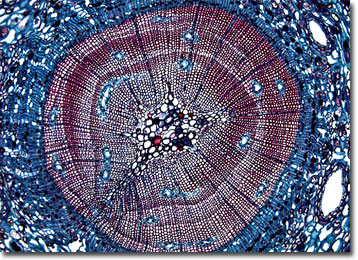Brightfield Microscopy Digital Image Gallery
Pine Stem
Pine is the common name for any tree belonging to the genus Pinus of the family Pinaceae, the largest of all families of conifers. Commercially valuable, pines are heavily grown as both ornamentals and timber trees, over 50 different species of the trees being cultivated in the United States alone.

View an image of the pine stem section at 20x magnification.
Chiefly found in northern temperate regions, most pines exhibit woody stems covered by bark, which helps protect the inner tissues that conduct water and nutrients from the roots of the trees to the leaves. These slender, lance-like leaves, typically referred to as needles, are extremely efficient and usually remain green year-round, resulting in the pine tree’s alternative moniker evergreen. In fact, pine needles, which are organized into bundles, may remain attached to a tree for as many as 17 years. When they do finally fall to the ground they may be utilized for a variety of purposes, especially as a type of mulch and as a material to construct woven baskets.
Pine trees are gymnosperms, non-flowering plants that bear naked seeds. They are also monoecious, the reproductive cells of both males and females being present on each tree. These cells, or gametes, are housed in the widely familiar pinecone, also known as a strobilus. In nature’s attempt to reduce self-fertilization, cones are usually located in different areas of the tree depending on their sex. Female cones are typically found in the crown of the pine above the male strobili, greatly reducing the possibility that they can become fertilized by the wind-born male gametes bore on their own tree.
BACK TO THE BRIGHTFIELD MICROSCOPY IMAGE GALLERY
